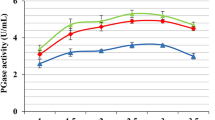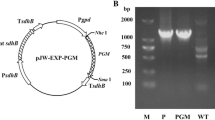Abstract
Inactivation of the pgg2 gene, a polygalacturonase-encoding gene from Penicillium griseoroseum, reduced the total activity of polygalacturonase (PG) by 90 % in wild-type P. griseoroseum, which indicates that the pgg2 gene is the major gene responsible for PG production in this species. To increase PG production, the coding region of the pgg2 gene was cloned under the control of the glyceraldehyde 3-phosphate dehydrogenase (gpd) promoter and the terminator region of the tryptophan synthase (trpC) gene from Aspergillus nidulans (pAN52pgg2 vector). This vector was then used to transform P. griseoroseum. The transformed strains were characterized according to PG production using glucose, sucrose, or sugar cane juice as the carbon sources. The recombinant P. griseoroseum T146 strain contained an additional copy of the pgg2 gene, which resulted in a 12-fold increase in PG activity when compared with that detected in the supernatant of the control PG63 strain. The proteins secreted by the recombinant strain T146 showed a strong band at 38 kDa, which corresponds to the molecular weight of PG of the P. griseoroseum. The results demonstrate the significant biotechnological potential of recombinant P. griseoroseum T146 for use in PG production.





Similar content being viewed by others
References
Benen, J. A., Kester, H. C., & Visser, J. (1999). European Journal of Biochemistry, 259, 577–585.
Pedrolli, D. B., Monteiro, A. C., Gomes, E., & Carmona, E. C. (2009). The Open Biotechnol J., 3, 9–18.
Kashyap, D. R., Vohra, P. K., Chopra, S., & Tewari, R. (2001). Bioresource Technology, 77, 215–227.
Sandri, I. G., Fontana, R. C., Barfknecht, D. M., & Silveira, M. M. (2011). LWT- Food Science and Technology, 44(10), 2217–2222.
Lang, C., & Dornenburg, H. (2000). Applied Microbiology and Biotechnology, 53(4), 366–375.
Williams, H. L., Tang, Y., & Hintz, W. E. (2002). Fungal Genetics and Biology, 36(1), 71–83.
Mertens, J. A., Burdick, R. C., & Rooney, A. P. (2008). Fungal Genetics and Biology, 45(12), 1616–1624.
Yuan, P., Meng, K., Huang, H., Shi, P., Luo, H., Yang, P., et al. (2011). Food Chemistry, 129(4), 1369–1375.
Ribon, A. O. B., Coelho, J. L. C., Barros, E. G., & Araújo, E. F. (1999). Biotechnology Letters, 21, 395–399.
Ribon, A. O. B., Queiroz, M. V., & Araújo, E. F. (2002). Genetics and Molecular Biology, 25(4), 489–493.
Ribon, A. O. B., Queiroz, M. V., Coelho, J. L. C., & Araújo, E. F. (2002). Journal of Industrial Microbiology and Biotechnology, 29(3), 145–148.
Pereira, J. F., Queiroz, M. V., Lopes, F. J., Rocha, R. B., Daboussi, M. J., & Araújo, E. F. (2004). Canadian Journal of Microbiology, 50(11), 891–900.
Diolez, A., Langin, T., Gerlinger, C., Brygoo, Y., & Daboussi, M. J. (1993). Gene, 131, 61–67.
Punt, P. J., Dingemanse, M. A., Jacobs-Meijsing, R. I. M., Pouwels, P. H., Van Den Honda, L. C. A. M. J. I. (1988) Gene. 69, 49–57.
Cardoso, P. G., Ribeiro, J. B., Teixeira, J. A., Queiroz, M. V., & Araújo, E. F. (2008). Journal of Industrial Microbiology and Biotechnology, 35, 159–166.
Dias, E. S., Araújo, E. F., Guimarães, W. V., Coelho, J. L., & Silva, D. O. (1997). Revista de Microbiologia, 28, 116–120.
Queiroz, M. V., Barros, A. O., Barros, E. G., Guimarães, W. V., & Araújo, E. F. (1998). Canadian Journal of Microbiology, 44, 1–3.
Pontecorvo, G., Roper, J. A., Hemmons, L. M., MacDonald, K. D., & Bufton, A. W. J. (1953). Advances in Genetics, 5, 141–238.
Calam, C. T. (1969) In: Norris JR, Ribbons DW (ed). Methods in microbiology. London, Academic Press I, 567–591.
Specht, C. A., Dirusso, C. C., Novotny, C. P., & Ullrich, R. C. (1982). Analytical Biochemistry, 119(1), 158–163.
Southern, E. M. (1975). Journal of Molecular Biology, 98, 503–517.
Pfaffl, M. W. (2001). Nucleic Acids Research, 29(9), e45.
Miller, G. L. (1959). Analytical Chemistry, 31, 426–428.
Laemmli, U. K. (1970). Nature, 227, 680–685.
Bradford, M. M. (1976). Analytical Biochemistry, 72, 248–254.
Chellegatti, M. A. S. C., Fonseca, M. J. V., & Said, S. (2002). Microbiology Research, 157, 19–24.
Mohamed, S. A., Farid, N. M., Hossiny, E. N., & Bassuiny, R. I. (2006). Journal of Biotechnology, 127, 54–64.
Damásio, A. R. L., Silva, T. M., Maller, A., Jorge, J. A., Terenzi, H. F., & Polizeli, M. L. T. M. (2009). Applied Biochemistry and Biotechnology, 160(5), 1496–507.
Levasseur, A., Benoit, I., Asther, M., & Record, E. (2004). Protein Expression and Purification, 37(1), 126–133.
Jongh, W. A., & Nielsen, J. (2008). Metabolic Engineering, 10(2), 87–96.
Kolar, M., Punt, P. J., Van Den Hondal, C. A. M. J. J., Sehwab, H. (1988) Gene. 62, 127–134.
Chen, X., Liang, Y., Hua, J., Tao, L., Qin, W., & Chen, S. (2010). International Journal of Biological Sciences, 6(1), 96–106.
Meyer, V. (2008). Biotechnology Advances, 26(2), 177–185.
Bussink, H. J. D., Van Den Hombergh, J. P. T. W., Van Den Ijssel, P. R. L. A., & Visser, J. (1992). App Microbiol Biotechnol., 37, 324–329.
Graessle, S., Haas, H., Friedlin, E., Kürnsteiner, H., StöZer, G., & Redl, B. (1997). Applied and Environmental Microbiology, 63, 753–756.
Acknowledgments
This research was supported by the Brazilian agencies Minas Gerais State Research Foundation (Fundação de Amparo à Pesquisa do Estado de Minas Gerais (FAPEMIG)) and the National Council for Scientific and Technological Development (Conselho Nacional de Desenvolvimento Científico e Tecnológico–CNPq).
Author information
Authors and Affiliations
Corresponding author
Rights and permissions
About this article
Cite this article
Teixeira, J.A., Ribeiro, J.B., Gonçalves, D.B. et al. Overproduction of Polygalacturonase by Penicillium griseoroseum Recombinant Strains and Functional Analysis by Targeted Disruption of the pgg2 Gene. Appl Biochem Biotechnol 169, 1965–1977 (2013). https://doi.org/10.1007/s12010-013-0121-6
Received:
Accepted:
Published:
Issue Date:
DOI: https://doi.org/10.1007/s12010-013-0121-6




